The Great Book of Ireland rivals
The Book of Kells
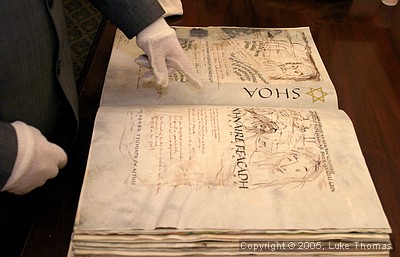
Photo(s) by
Luke Thomas
By Pat Murphy
Copyright fogcityjournal.com 2005
December 1, 2005
An Irish literary time capsule, crafted to rival the Book of
Kells and be caressed by marveling posterity 1000 years from now,
made its way into the gentlest of white-gloved San Franciscan
hands Wednesday.
The Great Book of Ireland, begun on June 11, 1991, means to immortalize
contributions of 140 writers and 120 artists from this age, and
is on tour in wait of the ages.
It draws its energy, its power, its many cries, from an Ireland
in time of independence and democracy.
And so the decision was made to bring it not to a closed intelligentsia
setting, but to the people's house, San Francisco City Hall, under
auspices of Supervisor Ross Mirkarimi and be available to touch
by all.
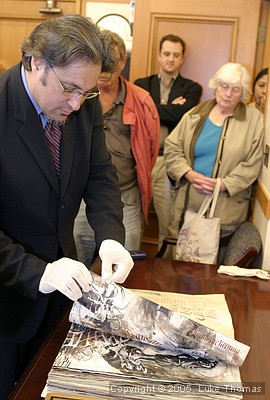
Supervisor Ross Mirkarimi
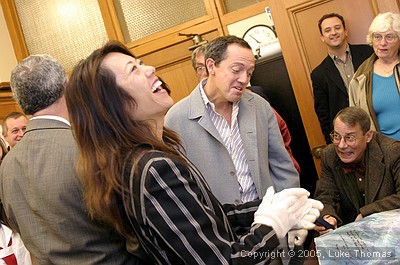
"I want to see Joe
O'Donoghue's poems in there!" insisted Supervisor Fiona
Ma, bringing laughter to Supervisor Bevan Dufty at her side and
Supervisor Sean Elsbernd, married in an Irish Kilt three weeks
ago, shown in background.
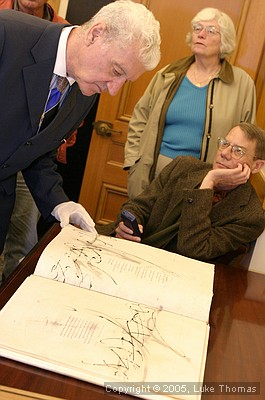
'Tis himself, Joe O'Donoghue, a longtime leader in San Francisco's
Irish community who helped coordinate visit of the Great Book
of Ireland to San Francisco.
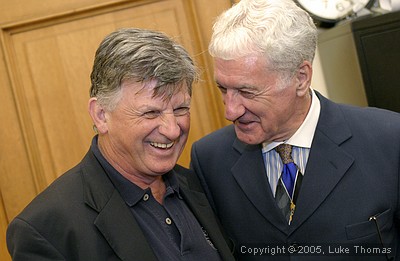
Brendan McBride, left, serves as chaplain of the San Francisco
Irish Immigration Pastoral Center. McBride is a native of County
Donegal.
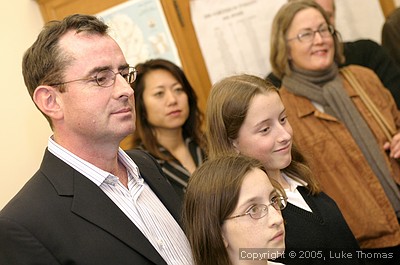
Ina and Emma Herlihy of St Cecilia's with ther father, Eamonn,
will be the next generation to remember the last preserved through
the artistry of The Great Book of Ireland.
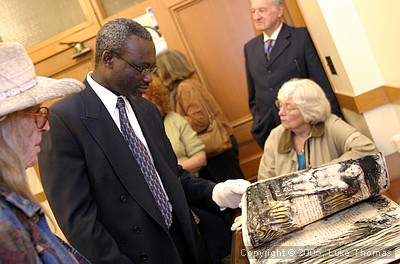
Yomi Agunbiade, director of the San Francisco Department of Recreation
and Parks, joined admirers.
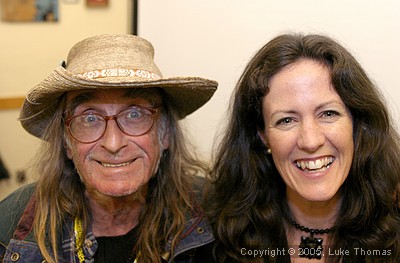
Few artist gatherings convene without presence of Diamond Dave,
shown with Dr Jean van Sinderen-Law, director of development at
University College, Cork.
The Book of Kells, painstakingly produced in the 800s, captures
an Ireland of different times, of different direction than the
Ireland of today.
Contributors to the Great Book wanted to create a vision of Ireland
updated for future generations as a companion to the Book of Kells.
"Without realizing it, we had begun the process of recovering
a tradition, but when the gospels were written in the Book of
Kells it was an attempt to create a unitary culture under a single
faith with a single priestly class ruling it," Theo Dorgan
said, poet and editor of the Great Book.
"Our time is a time of independence and personal liberty.
"One thousand years hence people will be reading this -
people like us, or people very unlike us.
"But they will be able to put their hands on a book - maybe
when books will have been forgotten, maybe when books will not
be the instruments of knowledge - and they will think of us as
a people of the book.
"Nothing is without political significance. It's absurd
to think it is. This book is a sign in the name of a tradition,
but it's also an act of faith in the meaning of the book.
"It says books are a part of our life. The things we write,
the things we paint, matter."
Cultural voices from the Great Book speak with vitality of many
Irish cultures. Secular. Roman Catholic. Protestant. Jewish. Muslim.
Atheist.
But all cry out from that soul peculiar to the Irish, which forged
a land where all the wars are merry, and all the songs are sad.
The most repeated themes are black birds and skeletons.
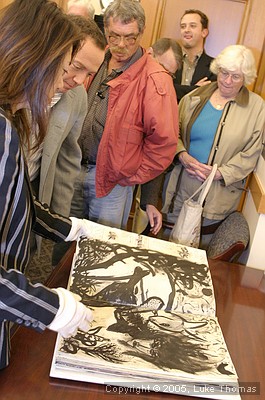
Conceived and produced largely from the seed of County Cork,
the Great Book's permanent home is the Colaiste na hOllscoile,
Corcaigh - University College, Cork.
Although left unspoken, placement in County Cork is itself a
political statement signifying popular move toward preeminence
of Irish culture.
County Dublin, home of the East Side national capital, is long
known as the land of the seonin - the land of the West
Brit; the Irish who prefer English culture over their own.
The Great Book is "not just a thing. It's a force field,"
noted Dorgan.
"And the reason we wanted to put it in the University is
that the University of Cork is restating itself as a force of
energy in the Province of Munster as the alternative to Dublin.
"It reflects independence, variety, contradiction,"
Dorgan said.
The book contains the best of the best as gathering in one vessel
-- for some contributors the Great Book of Ireland was their final
life's gift.
Samuel Becket sent an entry two weeks before he died.
"A week after Beckett died, his lifelong friend Louis le
Brocquy made this image of him. I'm going to stand back so you
can see it from a distance…I can't help but think that Louis
made it like this because the sun was already receding from him,
he was already going away, he was fading back into time,"
Drogan reported.
"That's done," signed Becket on his contribution, believed
to be Becket's last written words.
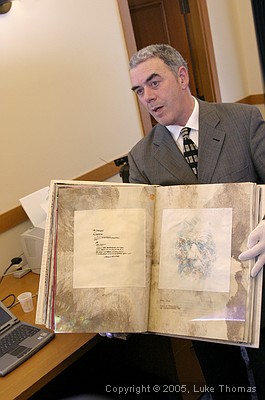
Samuel Becket portrait by Louis le Brocquy
with life's final work of Samuel Becket.
Continuation was born at 4:45 p.m., November 30, 2005, as Dorgan
planted idea for a similarly produced Great Book of San Francisco.
"Wouldn't this be a great time in San Francisco for you
to say that your book matters, that arts matters?" whispered
Dorgan.
"I think that time just began," responded Mirkarimi,
with his special cadre of the special artists of San Francisco.
For more information on the Great Book of Ireland, its development
and contributors, visit Poetry Ireland by
clicking here.
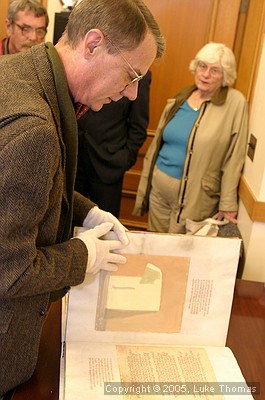
####

|